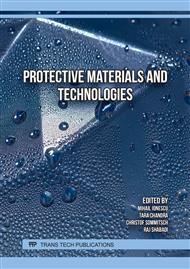p.29
p.35
p.41
p.49
p.55
p.63
p.69
p.75
p.81
Investigation of Effects of Electroplating Conditions on TEMPO-Oxidized Cellulose Nanofiber Composited Nickel Electroplated Films
Abstract:
The effects of plating conditions on nickel (Ni) electroplated films composited with 2,2,6,6-tetramethylpiperidine 1-oxyl (TEMPO)-oxidized CNFs (CNFs) were investigated. Plating experiments were performed by varying the amount of CNFs added to the Watt's bath, the current density, and the stirring speed. The plated film obtained at 3 g/L, 2.5 A/cm2, and 300 rpm of them respectively, reached an average 483 HV of the surface hardness, which was the highest in this study. The surface hardness of the conventional Ni film without CNFs plated under the same conditions was an average of 239 HV, and the hardness improvement effect was more than twice as high. The hardness improvement effect due to dispersion enhancement tended to increase as more CNFs were more finely and densely composited into the Ni film, although different trends were observed when the current density was varied.
Info:
Periodical:
Pages:
55-62
Citation:
Online since:
December 2023
Authors:
Price:
Сopyright:
© 2023 Trans Tech Publications Ltd. All Rights Reserved
Share:
Citation:



